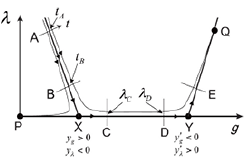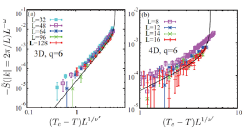A Scaling Relation for Dangerously Irrelevant Symmetry-Breaking Fields
Kawashima Group
We studied the effect of a dangerously irrelevant symmetry-breaking field on critical phenomena and obtained a new scaling relation. We verified the relation by numerical calculation of the classical XY model with Z6-symmetry breaking field in three and four dimensions.

Fig. 1. The generic renormalization flow diagram with four fixed points: P, Q, X, and Y.

Fig. 2. Log-log plot of the angular Fourier transform of the angle dependent spin-structure factor ˜S for the Z6-anisotropic XY model with λ6/J = 5 in three dimensions (a) and in four dimensions (b). For (a) the estimates obtained through the scaling relation ω = 1.983 and ν' = 1.511 are used. (b) The corresponding finite-size scaling plot assuming ω = 2.0 and ν' = 1 in four dimensions. The critical temperatures Tc/J = 2.202 for three dimension and Tc/J = 3.3143 for four dimentions are estimated from the binder ratios of the magnetization.
While irrelevant scaling fields play minor roles in most cases, some of them are quite relevant in the usual sense of the word. We studied the cases where such a dangerously-irrelevant scaling field reduces the symmetry of the system, and demonstrated that it yields a new scaling relation. We considered a generic renormalization-group flow diagram (Fig. 1) including two fixed points; one describing the critical point and the other the ordered phase. In the case described by this diagram, the perturbation λ may almost die out at some length scale, say ξ, while it may recover its amplitude at larger length scale, say ξ'. When the system size is between the two scaling lengths, ξ<<L<<ξ', the system would seem ordered but still no effect of the symmetry breaking can be detected. It may then appear that an intermediate phase exists where the system acquires an emergent symmetry. A classic example of this type of renormalization group flow is the q-state clock model in three dimensions, and its continuous-spin counterpart.
However, it is now widely accepted that in three dimensions there is no partially ordered phase with the emergent symmetry. Nevertheless, disagreement still persists concerning the scaling relation that relates the scaling exponent ν' and ν that characterize the longer and the shorter correlation length, respectively. Previously, a scaling relation was proposed by Ueno et al. [2] and by Oshikawa [3]. Their arguments are based on the basic assumption that there is a well-defined domain wall splitting the whole system and the excess free-energy caused by the domain walls is the scaling variable. The excess free-energy density per area of the domain wall may be given by the symmetry-breaking field renormalized up to the scale of locally-correlated volume, λ(ξ) ≈ λξyλ (yλ represents the scaling exponent of the symmetry-breaking field at the critical fixed point). The total domain-wall free-energy, then, may be Ld-1λ(ξ). This yields a scaling relation ν'/ν = −yλ(d−1). Lou, Sandvik, and Balents [4] presented a similar argument, but they argued that the effect of the anisotropy free-energy comes from the volume instead of the domain walls. Therefore, they multiply the renormalized field by the number of correlated volumes, to obtain ν'/ν = 1 − yλ/d.
We presented a new scaling relation, which is similar to what was speculated previously but is more general and yields different prediction in general. The bare Hamiltonian is along the short line near the point “A” parameterized by t so that t = 0 corresponds to the critical point. If we start from the point t = 0 on this line, the scaling flow takes us to the critical fixed point “X”, where g = gX and λ = 0. In the vicinity of X, the RG flow is characterized by y > 0 for the variable g and yλ < 0 for the variable λ. If we start from a point slightly off A, the scaling flow goes through the points “C”, “D”, and approaches the second fixed point “Y” around which renormalization group flow is characterized by scaling exponents y' < 0 and y'λ > 0. Because of the presence of λ, the flow deviates from “Y”, and eventually reaches some other fixed point. We obtained the new scaling relation
![]() ・
・
To verify the validity of this relation, we computed the structure factor of spin-fluctuation around the mean direction θ0:
![]() .
.
where the expectation value is evaluated with the spontaneous symmetry breaking along the direction specified by θ0. The Fourrier transformation of this quantity, ![]() is suppose to have the scaling behavior
is suppose to have the scaling behavior ![]() with ω≡2(d−yλ−2xh)/(2−yλ). Figure 2 is the scaling plot of our numerical results. The data are scaled with the exponents obtained through the scaling relations quoted above. While there are strong corrections to scaling, the data clearly converging to the expected scaling function as the system is enlarged.
with ω≡2(d−yλ−2xh)/(2−yλ). Figure 2 is the scaling plot of our numerical results. The data are scaled with the exponents obtained through the scaling relations quoted above. While there are strong corrections to scaling, the data clearly converging to the expected scaling function as the system is enlarged.
References
- [1] T. Okubo, K. Oshikawa, H. Watanabe, and N. Kawashima, Phys. Rev. B 91 174417 (2015).
- [2] Y. Ueno and K. Mitsubo, Phys. Rev. B 43, 8654 (1991).
- [3] M. Oshikawa, Phys. Rev. B 61, 3430 (2000).
- [4] J. Lou, A. W. Sandvik, and L. Balents, Phys. Rev. Lett. 99, 207203 (2007).
